The Scoop on Stevia!
By Alice Osborne
 Stevia (rebaudiana) is a plant native to South and Central America and belongs to the sunflower family (Asteraceae). Altogether there are 240 species of the stevia plant. It has been used as an alternative to sugar in Paraguay and Brazil for over 500 years. The extract of the plant is up to 300 times sweeter than sugar. So you only need one or two leaves of it, to sweeten one cup of strong coffee or tea.
Stevia (rebaudiana) is a plant native to South and Central America and belongs to the sunflower family (Asteraceae). Altogether there are 240 species of the stevia plant. It has been used as an alternative to sugar in Paraguay and Brazil for over 500 years. The extract of the plant is up to 300 times sweeter than sugar. So you only need one or two leaves of it, to sweeten one cup of strong coffee or tea.
Are there any negative side affects? Not so far as the research has been able to turn up thus far. However, it is currently forbidden as a food additive in the European Union and some other countries. Some people say that there are still not enough confirmed studies to confirm that stevia isn’t definitively harmful in any way.
BUT, stevia has been a healing plant and a sweetener for native populations for many hundreds years and has been used in Japan and Brazil as a healthy sweetener for 30 years. The USA allows Stevia use at least for diet food.
It would be good if more studies were in progress, but the problem is as always research funding. Who’s going to pay for these experiments? The sugar industry, which could be a possible sponsor, is afraid of stevia killing their business. And this is a well-founded fear. There’s simply too much anecdotal and historical evidence on the benefits of the plant to not take it seriously.
For instance, the World Health Organization says stevia has a negligible effect on blood glucose and even enhances glucose tolerance. That makes it not only a good natural sweetener not just for diabetics, but for almost everyone.
Stevia contains no calories yet is 300 times sweeter than table sugar and is good for the teeth—it is effective against caries and dental plaque. Other research is finding positive effects on obesity and high blood pressure. And to top it all off, it can be used for cooking and baking as it’s heat-resistant and perfectly water soluble. And I love that there’s no yucky after-taste that we find in some sugar alternatives. All this makes this sweet leaf a natural and healthy alternative to sugar and synthetically produced sweeteners.
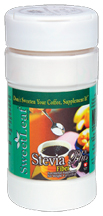 NOW, for the find of the day! SweetLeaf Stevia. The ad copy on their website says they only use cool purified water to extract from the highest quality leaves. I dunno if this is so, but I’ve tried lots of brands and this is my very favorite. SweetLeaf claims they’re the only company to extract this way and I can just say that whatever they’re doing, it works because the taste of this product is wonderful. Another thing I very much like about this company is its serious efforts to fight childhood obesity.
NOW, for the find of the day! SweetLeaf Stevia. The ad copy on their website says they only use cool purified water to extract from the highest quality leaves. I dunno if this is so, but I’ve tried lots of brands and this is my very favorite. SweetLeaf claims they’re the only company to extract this way and I can just say that whatever they’re doing, it works because the taste of this product is wonderful. Another thing I very much like about this company is its serious efforts to fight childhood obesity.
 Here’s what they founder of the company, Jim May has to say:
Here’s what they founder of the company, Jim May has to say:
The U.S. Centers for Disease Control considers obesity the number one health risk in America. Childhood obesity threatens the health of one in three American children. These kids are at higher risk of developing heart disease, stroke, type 2 diabetes, high blood pressure, asthma and certain types of cancers. This isn’t necessary—especially when it can be averted by awareness and making some lifestyle adjustments.
When I invested my life savings in the development of stevia products in 1982, childhood obesity was not the epidemic it is today. I’m pleased the product my company produces, SweetLeaf Stevia® Sweetener, provides a solution in the prevention of obesity. SweetLeaf® contains zero carbs, zero calories, zero glycemic index and is 100% natural. I have been very diligent about not compromising the integrity of our products so they won’t adversely impact health.
Preventing childhood obesity is where my personal and professional lives merge. I am passionate about doing what I can to contribute to optimum health, and I am becoming even more involved in working with both public and private organizations dedicated to ending childhood obesity. I am confident that, together, we can find ways to end childhood obesity.
 I share this passion, which is why I wanted to call attention to this product. Now here’s how I’m using Stevia. First, it’s good to have a conversion chart:\
I share this passion, which is why I wanted to call attention to this product. Now here’s how I’m using Stevia. First, it’s good to have a conversion chart:\

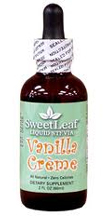 I use the extract powder and the Stevia Plus Powder in my cooking and baking. But my all time love is the concentrate liquid—vanilla cream flavor (and it comes in a wide variety of other flavors as well). This has NO alcohol in it so it is perfect for my fight against my candida albicans. I make a breakfast smoothie each morning that contains aloe vera juice (BITTER!) and fresh ginger and half a lemon (SOUR). I add plain goat milk yogurt (TART) and a few drops of the vanilla cream stevia, WOW! Is this good. You’d never know there was anything bitter, sour or tart in the concoction at all.
I use the extract powder and the Stevia Plus Powder in my cooking and baking. But my all time love is the concentrate liquid—vanilla cream flavor (and it comes in a wide variety of other flavors as well). This has NO alcohol in it so it is perfect for my fight against my candida albicans. I make a breakfast smoothie each morning that contains aloe vera juice (BITTER!) and fresh ginger and half a lemon (SOUR). I add plain goat milk yogurt (TART) and a few drops of the vanilla cream stevia, WOW! Is this good. You’d never know there was anything bitter, sour or tart in the concoction at all.
If you haven’t tried this product, here are a few recipes to get you started, taken from the SweetLeaf website. Let me know what you think, but meanwhile, here’s to good health!
Pumpkin Pie
 2 cups pumpkin puree
2 cups pumpkin puree20 packets SweetLeaf Stevia®
2 cups half & half
1 Tablespoon cinnamon
½ teaspoon nutmeg
1 teaspoon pumpkin spice
4 whole eggs
Combine all the ingredients, pour into two 4 inch pie shells and bake at 325° F for 25 minutes.
Sugar-Free Apple Pie
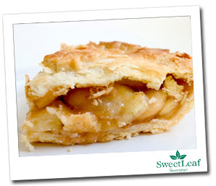 Pastry dough for 9″ 2-crust pie
Pastry dough for 9″ 2-crust pie10 packets SweetLeaf Stevia®
1/2 teaspoon salt
1 1/4 teaspoon cinnamon
1/2 teaspoon nutmeg
2 1/2 to 3 tablespoons arrowroot powder
3 to 4 large, firm, tart apples
2 tablespoons butter
1/2 teaspoon xanthan gum
Preheat the oven to 425F (220C). Peel, core, and slice the apples. Line a 9-inch pie pan with half the pastry dough. Mix the dry ingredients in a large bowl. Add apples to the dry mixture, coating them well. Pile them into the lined pan and dot with the butter. Roll out the top crust and drape it over the pie, or lattice weave strips of dough over the top. Brush the latticed dough with egg and dust with cinnamon. Crimp the edges and cut several vents in the top. Bake 10 minutes, then lower the heat to 350F (180C) and bake 30-40 minutes more or until the apples are tender when pierced with a skewer and the crust is browned.
Apple Oatmeal Muffins
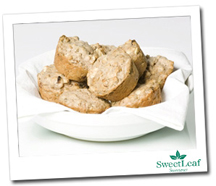 1 cup all-purpose or whole-wheat flour
1 cup all-purpose or whole-wheat flour1 cup rolled oats
½ teaspoon salt
3 teaspoon baking powder
½ teaspoon nutmeg
2 teaspoon cinnamon
15 packets SweetLeaf Sweetener®
1 egg
¾ cup milk
¼ cup applesauce (can substitute vegetable oil)
1 medium-sized apple, cored and coarsely chopped
¾ cup raisins
Preheat oven to 400 degrees. Mix first seven ingredients thoroughly. In separate bowl, mix remaining ingredients. Gradually mix dry ingredients into moist ingredients. Spoon into greased muffin tins. Bake 15-20 minutes. Try this with nuts or sliced almonds on the top! Makes about 12 muffins.
Fresh Blueberry Muffins
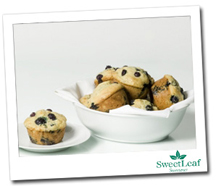 ½ cup rolled oats
½ cup rolled oats6 ounces pineapple juice
¼ cup vegetable oil
1 egg
1 teaspoon vanilla extract
15 packets SweetLeaf Sweetener®
2 ounces milk
½ cup plain yogurt
1 ¾ cups all purpose or whole wheat pastry flour
1 teaspoon baking soda
¼ teaspoon salt
1 cup fresh or frozen blueberries
Heat oven to 375 F. Oil a muffin pan. In a small bowl, soak the oats in the pineapple juice for 10-15 minutes. Set aside. Beat together the oil, egg and vanilla in a mixing bowl. Mix the milk into the yogurt to thin it, then add to the egg mixture. Fold into the oatmeal mixture. Sift together the flour, baking soda, SweetLeaf Sweetener® and salt. Fold the dry ingredients into the wet ingredients, stirring as little as possible. Fold in the blueberries just before the flour is completely blended. Spoon the batter into the muffin pan and bake for 25-30 minutes. Makes about 12 muffins.

Contribute to the Cook'n Club!
DVO would love to publish your article, prose, photography and art as well as your cooking, kitchen and nutrition tips, tricks and secrets. Visit the Newsletter Submission / Win Win for All section in our Forum for more information and details.

